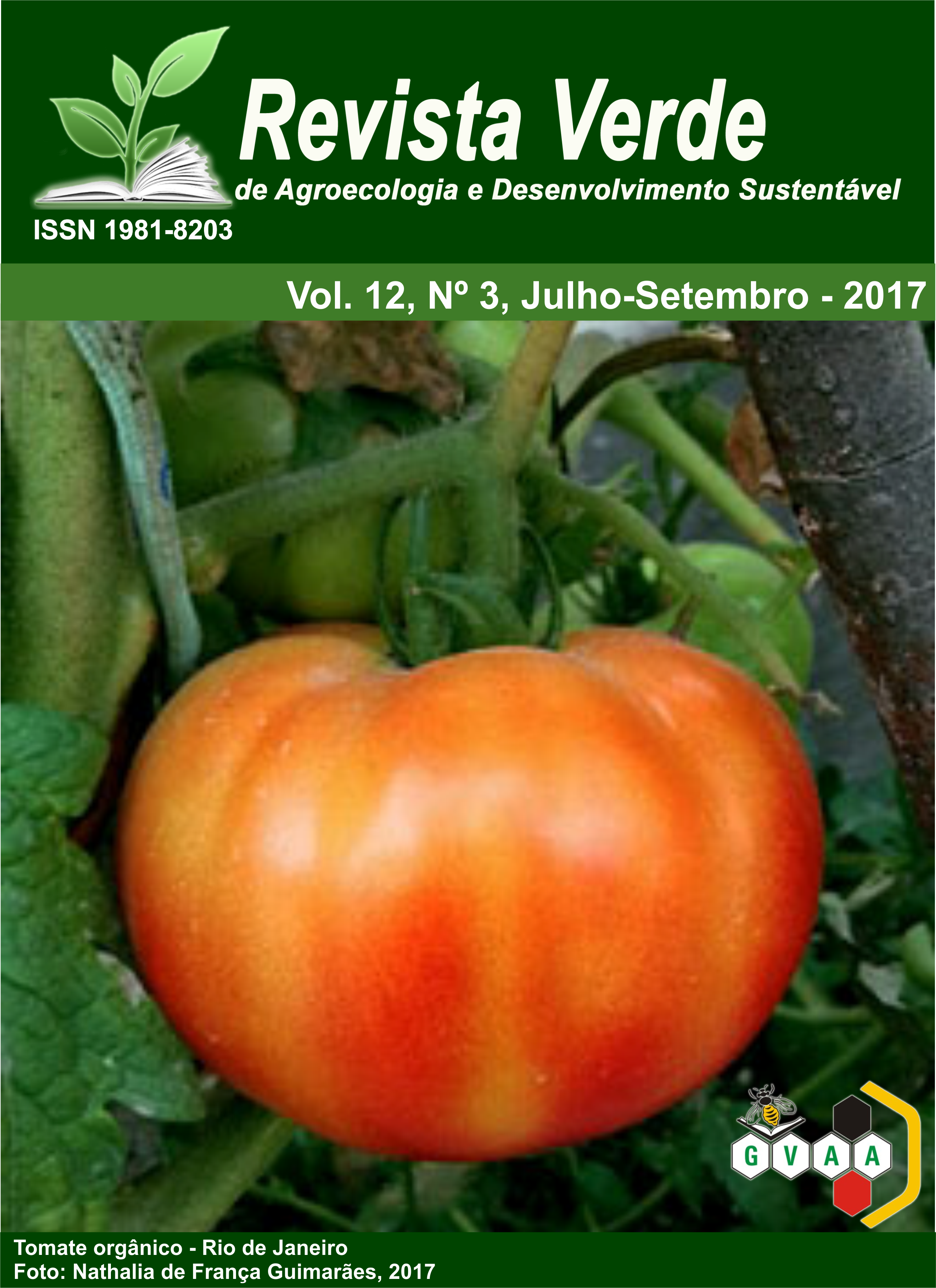Occurrence of Brassolis sp. in mangroves along the Apodi-Mossoró River estuary, Rio Grande do Norte
DOI:
https://doi.org/10.18378/rvads.v12i3.4856Keywords:
Caterpillar, Lepidoptera, Mangrove, Butterflies.Abstract
Mangroves are coastal ecosystems and although the main degradation factors of mangroves are well known and documented, few records deals with the occurrence of pests that attack mangrove vegetation. The caterpillars Brassolis sp. when colonizing mangrove plants, cause defoliation, leaving only the central veins of the leaflets and the rachis of each leaf. In this way, it was verified the occurrence of Brassolis sp. in mangroves along the Apodi-Mossoró River estuary, in the municipality of Mossoró, Rio Grande do Norte. A random, minimum sampling of 10% of the total mangrove species Avicennia germinans, Avicennia schaueriana, Laguncalaria racemosa and Rhyzophora mangle was collected for two years in which pupae, caterpillars and moths were collected for later identification. Subsequently, an alternative test solution was applied to the pesticides that were sprayed on the mangrove species infested once a week (during 4 weeks) after the collection period of each year, then the presence or absence of the larval, pupa and moth, as well as their behavior. Insects Brassolis sp. attack and infest the mangrove species Avicennia germinans, Avicennia schaueriana, and Rhyzophora mangle, with no evidence that they can infest Laguncalaria racemosa. The solution tested as control of insect infestation Brassolis sp. causes lethargy of caterpillars and death of pupae and moths after 4 weeks of use, however its application in periods of proliferation of these insects (rainy season) is necessary for greater control of this pest in mangroves.
Downloads
References
ANDRADE, R. S. Aspectos e conservação da biodiversidade na Comunidade Quilombola Santa Cruz–Brejo Grande/SE. Revista de Geociências do Nordeste, Caicó, v. 2, n. especial, p. 832-840, 2016.
BARBIER, E. B. Valuing ecosystem services as productive inputs. Economic Policy, v.22, n.49, Oxford, p.177–229, 2007.
CARNEIRO, M. A. B.; FARRAPEIRA, C. M. R.; SILVA, K. M. E. O manguezal na visão etnoecológica dos pescadores artesanais do Canal de Santa Cruz, Itapissuma, Pernambuco, Brasil. Biotemas, Santa Catarina, v.21, n.4, p.147-155, 2008.
CUENCA, M. A. G. A cultura do coqueiro: Importância econômica da cocoicultura no Brasil. Embrapa Tabuleiros Costeiros. 2007., Disponível em: <http://sistemasdeproducao.cnptia.embrapa.br/FontesHTML/Coco/ACulturadoCoqueiro/importancia.htm>. Acesso em: 01 nov. de 2017.
DUKE, N. C.; MEYNECKE, J. O.; DITTMANN, S.; ELLISON, A. M.; ANGER, K.; BERGER, U.; CANNICCI, S.; DIELE, K.; EWEL, K. C.; FIELD, C. D.; KOEDAM, N.; LEE, S. Y.; MARCHAND, C.; NORDHAUS, I.; DAHDOUH-GUEBAS, F. A world without mangroves? Science, Pensilvânia, v.317, n.5834, p.41–42, 2007.
FERNANDES, R. T. V. Recuperação de Manguezais. 1.ed. Rio de Janeiro: Interciência, 2012. 78p.
FERREIRA, J. M. S.; FILHO, M. M. A cultura do coqueiro: Pragas e métodos de controle. Embrapa Tabuleiros Costeiros. 2007. Disponível em: <http://sistemasdeproducao.cnptia.embrapa.br/FontesHTML/Coco/ACulturadoCoqueiro/prag
as.htm>. Acesso em: 01 nov. de 2017.
FONTES, H. R.; FERREIRA, J. M. S.; SIQUEIRA, L. A. 2002. Sistema de Produção para a Cultura do Coqueiro. Embrapa Tabuleiros Costeiros, 2002.
GALLO, D.; NAKANO O.; NETO, S. S.; CARVALHO R. P. L.; BATISTA, G. C.; FILHO, E. B., PARRA, J. R. P.; ZUCCHI, R. A.; ALVES, S. B.; VENDRAMIM, J. D.; MARCHINI, L. C.; LOPES, J. R. S.; OMOTO C. Entomologia agrícola. Piracicaba: FEALQ, 2002. 920p.
LEE, S. Y.; PRIMAVERA, J. H.; DAHDOUH-GUEBAS, F.; MCKEE, K. BOSIRE, J. O.; CANNICCI, S.; DIELE, K.; FROMARD, F.; KOEDAM, N.; MARCHAND, C.; MENDELSSOHN, I.; MUKHERJEE, N.; RECORD, S. Ecological role and services of tropical mangrove ecosystems: a reassessment. Global Ecology and Biogeography, v.23, n.7, p.726–743, 2014.
LUTHER, D.; GREENBURG, R. Mangroves: a global perspective on the evolution and conservation of their terrestrial vertebrates. Bioscience, v.59, n.7, p. 602–612, 2009.
MACAGNAN, R.; MACAGNAN, R.; WERNER, F; REGO, B. E. F.; BARP, E. A. Eficácia de extratos vegetais no controle de Spodoptera frugiperda (JE SMITH, 1797) em milho. Biosaúde, Londrina, v.14, n.2, p.74-80, 2016.
OLIVEIRA, M. S. S.; ROEL, A. R.; ARRUDA, E. J.; MARQUES, A. S. Eficiência de produtos vegetais no controle da lagarta-do-cartucho-do-milho Spodoptera frugiperda (J.E.Smith, 1797) (Lepidoptera: Noctuidae). Ciência e Agrotecnologia, Lavras, v.31, n.2, p.326-330, 2007.
RODRIGUES, L. L.; FARRAPEIRA, C. M. R. Percepção e educação ambiental sobre o ecossistema manguezal incrementando as disciplinas de ciências e biologia em escola pública do Recife-PE. Investigações em Ensino de Ciências, Porto Alegre, v.13, n.1, p.79-93, 2016.
TORRES, A. L.; BOIÇA JÚNIOR, A. L.; MEDEIROS, C. A. F.; BARROS, R. Efeito de extratos aquosos de Azadiractha indica, Mella azedarach e Aspidosperma pyrifolium no desenvolvimento e ovoposição de Plutella xylostella. Bragantia, Campinas, v.65, n.3, p. 447-457, 2009.
VIANA, P. A.; PRATES, H. T. Desenvolvimento e mortalidade larval de Spodoptera frugiperda em folhas de milho tratadas com extrato aquoso de folhas de Azadirachta indica. Bragantia, Campinas, v.58, n.1, p.54-79, 2003.
ZORZENON, F. J. Principais pragas das palmeiras. In: ALEXANDRE, M. A. V; DUARTE, L. M. L.; CAMPOS-FARINHA, A. E. C. (eds.) Plantas ornamentais: doenças e pragas, 2008. cap. 10 p. 207-247.













